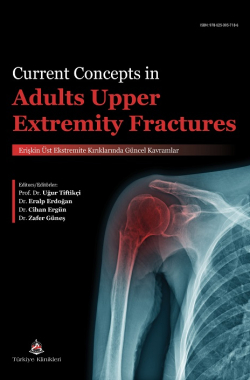ASSESSMENT OF FUNCTIONAL OUTCOMES AND QUALITY OF LIFE FOLLOWING FRACTURES
Alp Karaçoban
Ankara Atatürk Sanatoryum Training and Research Hospital, Department of Orthopedics and Traumatology, Ankara, Türkiye
Karaçoban A. Assessment of Functional Outcomes and Quality of Life Following Fractures. In: Tiftikçi U, Erdoğan E, Ergün C, Güneş Z, editors. Current Concepts in Adults Upper Extremity Fractures. 1st ed. Ankara: Türkiye Klinikleri; 2025. p.397-400.
ABSTRACT
As in the body every part of, upper extremity trauma individuals encounter problems such as pain, sensory problems, weakness, limitation in normal joint movement and functional decreased capacity. There are used many assessments evaluate the activity, impairment and participation limitations that occur as a result of these problems. It is important to evaluate fractures and treatment results. Certain parameters have been developed for this purpose. These evaluation systems must be reliable, valid and repeatable. A balance must be achieved between a tool that addresses multiple areas for a thorough assessment of a patient’s condition and that remains concise enough for practical application. As a result of the relationship between these evaluation tests, the best treatment method is tried to be determined. Evaluation tests can be performed separately for each fracture area, or the same tests can be used for different fracture areas. Functional assessment tools can be categorized into performance based and patient reported types. Performance-based measures assess an individual’s physical capabilities and are typically objective, minimizing personal interpretation. The DASH questionnaire is not designed to assess a specific joint; rather, it evaluates the overall function of both upper extremities. DASH is a common test used to evaluate the shoulder, arm and hand. The DASH test comprises 30 questions aimed at evaluating functional impairments in the upper extremity. The “Constant Shoulder Score” is utilized as an outcome measure to compare shoulder function both before and after treatment. The PREE (Patient Rated Elbow Evaluation) is a patient-centered outcome measure specifically designed for the elbow, featuring 20 numerical scales to evaluate pain and functional abilities. PRWE (Patient Rated Wrist Evaluation) and Mayo Wrist Score are functional scoring tests used to evaluate wrist injuries like distal radius fractures. The PRWE includes 15 questionnaire items that assess wrist pain and functionality in daily activities. Mayo Wrist Score includes 4 measurements, pain, function, rom and grip strength. In this chapter, the evaluation of functional outcomes and life quality after fracture will be explained.
Keywords: Fractures; Upper extremity; Quality of life; Outcome assessment
Kaynak Göster
Referanslar
- Skirven TM, Osterman AL, Fedorczyk J, Amadio PC. Rehabilitation of the Hand and Upper Extremity, 2-Volume Set E-Book: Expert Consult. Elsevier Health Sciences; 2011.
- Trail I. Operative Elbow Surgery. Churchill Livingstone; 2011.
- Changulani M, Okonkwo U, Keswani T, Kalairajah Y. Outcome evaluation measures for wrist and hand-which one to choose? Int Orthop. 2008;32:1-6. [Crossref] [PubMed] [PMC]
- Hudak PL, Amadio PC, Bombardier C, et al. Development of an upper extremity outcome measure: the DASH (disabilities of the arm, shoulder, and head). Am J Ind Med. 1996;29(6):602-608. [Crossref]
- Wylie JD, Beckmann JT, Granger E, Tashjian RZ. Functional outcomes assessment in shoulder surgery. World J Orthop. 2014;5(5):623. [Crossref] [PubMed] [PMC]
- Atroshi I, Gummesson C, Andersson B, Dahlgren E, Johansson A. The disabilities of the arm, shoulder and hand (DASH) outcome questionnaire: reliability and validity of the Swedish version evaluated in 176 patients. Acta Orthop Scand. 2000;71(6):613-618. [Crossref] [PubMed]
- Smith M V, Calfee RP, Baumgarten KM, Brophy RH, Wright RW. Upper extremity-specific measures of disability and outcomes in orthopaedic surgery. JBJS. 2012;94(3):277-285. [Crossref] [PubMed] [PMC]
- Constant CR, Gerber C, Emery RJH, Søjbjerg JO, Gohlke F, Boileau P. A review of the Constant score: modifications and guidelines for its use. J shoulder Elb Surg. 2008;17(2):355-361. [Crossref] [PubMed]
- MacDermid JC, Turgeon T, Richards RS, Beadle M, Roth JH. Patient rating of wrist pain and disability: a reliable and valid measurement tool. J Orthop Trauma. 1998;12(8):577-586. [Crossref] [PubMed]
- Fang C, Fang E, Yee DKH, Kwan K, Leung G, Leung F. A comparison of six outcome measures across the recovery period after distal radius fixation-Which to use and when? J Orthop Surg. 2021;29(1):2309499020971866. [Crossref] [PubMed]
- Vincent JI, MacDermid JC, King GJW, Grewal R. The Patient-Rated Elbow Evaluation and the American Shoulder and Elbow Surgeons-Elbow form capture aspects of functioning that are important to patients with elbow injuries. J Hand Ther. 2021;34(3):415-422. [Crossref] [PubMed]

